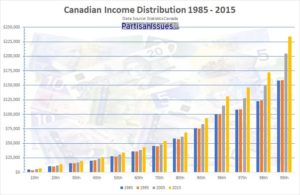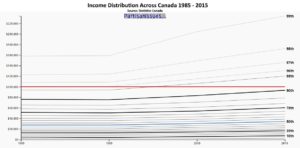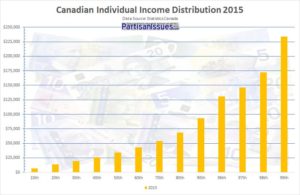Below are three graphs showing Canadian income distribution for an individual from 1985 through 2015. To get to the point, if you earn:
- $100K/year you are in the top 10% of Canadians
- $125K/year you are in the top 5% of Canadians
- $150K/year you are in the top 3% of Canadians
- $175K/year you are in the top 2% of Canadians
- $235K/year you are in the top 1% of Canadians
CLICK TO ENLARGE THESE GRAPHS
You may also find our very short article titled Income Map Of Canada: What Province Has The Highest Income Earners? (Hint: It’s Not Ontario or Quebec)
Below are some interesting finding from the 2016 Statistics Canada Household Income Survey:
- One-third of couples had fairly equal incomes in 2015 compared with about one-fifth of couples 30 years earlier.
- In 2015, 96% of Canadian couples had both spouses reporting income, up significantly from about two-thirds in the mid-1970s.
- Alberta ($93,835) had the third-highest median income among the provinces and territories in 2015, down from second place in 2005. Alberta was the fifth-fastest growing province/territory in Canada at 24.0%.
- New Brunswick ($59,347) had the lowest median income in Canada in 2015, followed by Quebec ($59,822). Median household income grew by 8.9% in Quebec from 2005, the second-slowest provincial/territorial growth rate in Canada over the decade. Montréal, the largest city in the province, had a median total income of $61,790 in 2015, up 8.8% from 2005.
- A smaller proportion of children aged 5 or younger were living in low income households in 2015, as the rate decreased from 18.8% to 17.8% over the decade
- The rate of senior Canadians in low income rose from 12.0% in 2005 to 14.5% by 2015
- In 1985, a man had relatively higher income in 71.3% of couples compared with 8.0% for women but by 2016, 50.7% of couples a male had relatively higher income while in 17.3% a female had relatively higher income.






3 Comments
dominoqq · January 15, 2020 at 2:34 am
Such clever observation about Trump and Android. I think you are correct. We are headed for a bi or tri-polar world of tech.
Anonymous · April 10, 2020 at 9:39 pm
Touche. Great arguments. Keep up the great work.
Dotty R · June 17, 2021 at 2:52 am
One thing I’ve noticed is that there are plenty of common myths regarding the lenders intentions any time talking about foreclosures. One fable in particular is the fact that the bank desires your house. The lending company wants your hard earned cash, not the home. Being in the top 10% of the income earners does not protect you from predators, it makes you a bigger target. Thanks for your write-up.